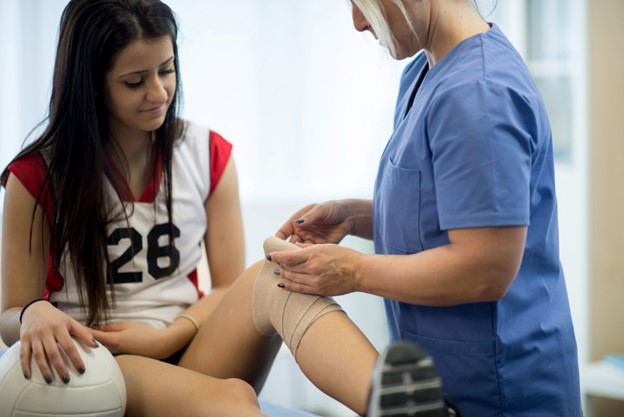Experiencing a sports injury can be a shocking and disheartening event, especially if you’re passionate about your physical activities. It’s important to handle the situation with care and know the right steps to take immediately after the incident occurs. This article will focus on what to do when sports injuries strike and how to initiate a smooth road to recovery.

Immediate Response
The first step after sustaining a sports injury is to assess the situation. If the injury is severe or if you are in intense pain, seek medical help immediately. However, for minor injuries like bruises or strains, incorporating the R.I.C.E. method can be beneficial:
- Rest: Avoid putting weight or using the injured area as much as possible. This gives the body time to heal and prevents further injury.
- Ice: Apply an ice pack to the injured area for 15-20 minutes every 2-3 hours. This helps reduce swelling and control inflammation.
- Compression: Wrapping the injured area with an elastic bandage can help reduce swelling and support the injury.
- Elevation: Keep the injured area elevated above the heart when lying or sitting down. This also helps in reducing swelling.
Injuries often become more painful or swollen in the first 24 hours following the incident, so managing these effects effectively is crucial.
Assessment and Diagnosis
Once the initial shock of the injury has passed, evaluating the severity is the next step. If the pain and swelling do not subside after a few days of self-treatment, it’s time to consult a healthcare professional. They can perform a thorough examination, potentially X-rays or MRIs, and diagnose the injury accurately.
Depending on the severity of the injury, the doctor may recommend over-the-counter pain medications or a prescription to manage pain and aid in recovery. They may also suggest a rehabilitation plan or physical therapy to restore strength and function to the injured area. In some cases, surgery may be necessary for a full recovery.
Long-term Recovery
Long-term recovery from a sports injury involves patience and a commitment to following the doctor’s advice. This often includes a combination of treatments such as:
- Physical Therapy: A program of exercises tailored to the specific injury to regain strength, flexibility, and range of motion.
- Medication: Sometimes ongoing medication is necessary to treat chronic pain or to reduce inflammation.
- Rest and Protection: In cases of more severe injuries, long periods of rest or wearing protective equipment may be necessary to prevent further damage.
- Surgery: For severe injuries, surgical repair might be the only option. Post-surgery care often includes immobilization and a specialized rehabilitation program.
Prevention for the Future
Preventing future injuries is just as important as treating the current one. Here are some steps to reduce the risk of sports-related injuries:
- Proper Warm-up and Cool Down: Never skip warming up before exercise and cooling down after to prepare the body for physical activity and recover properly.
- Use the Right Equipment: Be sure to use gear suitable for your activity, and make sure it fits correctly and is in good condition.
- Technique: Improper technique can lead to injury. Training with a coach or experienced athlete can make sure you’re doing things the right way.
- Listen to Your Body: If something doesn’t feel right, don’t push through the pain. It’s your body’s way of signaling that something is wrong.
By following these steps and being proactive in your recovery, you can get back to your favorite physical activities with confidence and peace of mind. Remember, the process takes time, so be patient and stay dedicated to the treatment plan for optimal results.Contact Greater Maryland Pain Management at 410-672-2255 today and take the first step towards getting back to your best physical condition. Our team is ready to support you through your healing journey with personalized care and effective treatment options.